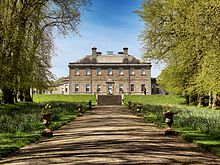Haddo House
Haddo House is a country house in the Scottish county of Aberdeenshire , approximately 20 miles north of Aberdeen . It is now owned by the National Trust for Scotland .
The Gordons , who later became the Earls of Aberdeen and Marquesses of Aberdeen , lived here for over 500 years. Haddo House is close to Kellie Castle , the former family seat built in 1732 and burned down by the Covenanters . The country house was designed by architect William Adam in Georgian and Palladian styles . The interior of the house is in the late Victorian style ; it was redesigned in 1880 by Wright and Mansfield . A large art collection is housed in Haddo House, e. As a series of images of 85 castles and palaces of the painter James Giles , an early work by Claude Lorrain and Marie-portrait that Raphael is ascribed. There are also a number of portraits of 19th century British politicians.
A specially created exhibition room contains the Cabot Commemorative State Dinner Service . The hand-painted porcelain set with 24 sets for an eight-course meal was made in 1897 by the members of the Woman's Art Association of Canada . The Canadian government did not want to pay the price of 1000 CDN- $ then demanded. Therefore, Members of the Parliament and Senate of Canada bought it privately and donated it to Lady Ishbel Aberdeen on June 12, 1898, on the occasion of the end of her husband's tenure as Governor General of Canada.
John Smith designed the kitchens and outbuildings in 1843. He returned to his place of work in 1845 and built the northern and southern gatehouses . The one-story building made of rough granite - dry stone are in Tudor style kept.
The most famous resident of Haddo House was George Hamilton-Gordon, 4th Earl of Aberdeen , British Prime Minister from 1852 to 1855.
Another notable period in the house's history was World War II when it was used as a maternity hospital for women evacuated from Glasgow . It is well known that almost 1200 babies were born in the Haddo Emergency Hospital and some of the "Haddo Babies" still come to visit today.
A small chapel is attached to the house . There is also a theater, Haddo House Hall , and practice rooms called Peatyards on the premises . Haddo House Choral & Operatic Society (HHCOS), a large and very active choral society, founded in 1945, has its base of operations here. It has been known for its annual music and opera productions for over 60 years.
In 1974, after the death of the 4th Marquess, the Gordons transferred the mansion and park to the National Trust for Scotland , which maintains it as a museum, but retained the agricultural and forestry property. Historic Scotland has listed Haddo House as a Category A Historic Building. His gardens are mentioned in the Inventory of Gardens and Designed Landscape .
Individual evidence
- ↑ a b c Haddo House . Archived by the National Trust for Scotland original on December 17, 2007. Retrieved August 9, 2017.
- ^ Haddo House . In: About Aberdeen . AboutAberdeen.com. Retrieved August 9, 2017.
- ^ The Cabot Commemorative State Service for Canada, 1897 - A History . Canadian Museum of History. Retrieved August 9, 2017.
- ^ David G. Miller: Tudor Johnny: City Architect of Aberdeen: The Life and Works of John Smith 1781-1852 . Librario. S. 348. 2007. Retrieved August 9, 2017.
- ↑ George Hamilton-Gordon, 4th Earl of Aberdeen . The Heraldry Society of Scotland. Retrieved August 9, 2017.
- ^ Haddo House . National Trust of Scotland. Retrieved August 9, 2017.
- ^ Peter Fraser: Haddo House C & O Society . OperaScotland.org. 2014. Retrieved August 9, 2017.
- ↑ Listed Building - Entry . In: Historic Scotland .
- ↑ Garden and Designed Landscape - entry . In: Historic Scotland .
Web links
Coordinates: 57 ° 24 ′ 10.8 " N , 2 ° 13 ′ 15.6" W.


